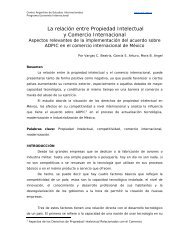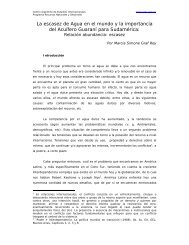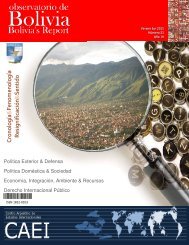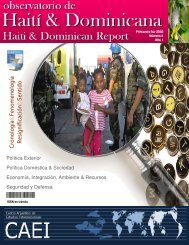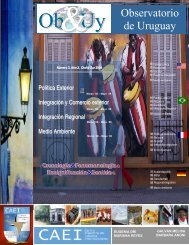Brazil's Defense Industry: The Emerging Transformational ... - CAEI
Brazil's Defense Industry: The Emerging Transformational ... - CAEI
Brazil's Defense Industry: The Emerging Transformational ... - CAEI
You also want an ePaper? Increase the reach of your titles
YUMPU automatically turns print PDFs into web optimized ePapers that Google loves.
empowerment of choices. It is the choices themselves that determine a nation’s level of defense and<br />
security, which stem from the collective will of the people within the borders of that country. <strong>The</strong>se<br />
people have chosen a way of life and, by their voting patterns, give an imprint to their government.<br />
Force Design reform results when sufficient domestic or external change gives cause for a nation’s<br />
government leadership to revise its assessment. Force Design addresses these same issues of<br />
spending and saving. In its most simplistic form, it can take the form of a budget cut by a specified<br />
percentage. Alternatively, it can be left to the Armed Services, which too often spend as much time<br />
and energy assessing how the other branches are faring as they do buttressing their established<br />
positions. Even more, the modern economic and management thought and science can be applied to<br />
force design.<br />
<strong>The</strong> ultimate function of the LAS as the result of force design is deliberating critical decisions that<br />
involve complex economic, technological, and capability requirement tradeoffs, cutting though the<br />
complexities of scheduling activities while avoiding the quagmire of detail, moving quickly in<br />
repositioning production resources either to orchestrate the acquisition or divestiture of function.<br />
Production resource allocation is just as important as human resources allocation, exercising<br />
interaction among defense industrial possibilities and operational functions. It consists of creating a<br />
pattern of decisions that affects the manufacturing of military assets and should be reflective of policy<br />
-- with careful attention to the potential interaction and driving forces within the national and<br />
international <strong>Defense</strong> industrial base. If properly allocated, production resources can play a unique<br />
role in defining, supporting, and enhancing the success of a defense project, operating in concert with<br />
all its functions.<br />
When force design is absent, decisions are based on a set of foundations seen as axiomatic and<br />
absolute only because they remain unexamined. As a result, ministries and the political leadership<br />
often appear to respond to events as they unfold. When problems arise, the problems become the<br />
focus of attention. In such situations, the urgency of decision-making in and of itself pushes aside the<br />
seemingly abstract notion of force design.<br />
Lacking an existing force design capability, inappropriate defense decisions taken on a tight timetable<br />
generally fail to take into account the various tradeoffs and cannot systematically examine their<br />
interaction(s). That is, decisions may tend to result in capabilities later to be found incapable of<br />
meeting <strong>Defense</strong> objectives, i.e., operational failure.<br />
<strong>The</strong> adoption requirement for a particular LAS influences the length of the asymmetrical advantages<br />
those adopters receive, changing the way technology matters for the security environment. This<br />
condition creates a context that validates the Brazilian Army endeavor to finance its major C4ISR<br />
project with dual use technology applied both to environment surveillance and military vigilance. A<br />
project budget in billions of carbon credits is under development—merging energy, environment and<br />
defense objectives.<br />
<strong>The</strong> collective pattern of the decisions taken into force design follows a logic stream regulated by its<br />
own results—each one stimulated and derived from the other. As programming is developed to<br />
10<br />
Todos los derechos reservados. - Pág.<br />
10





